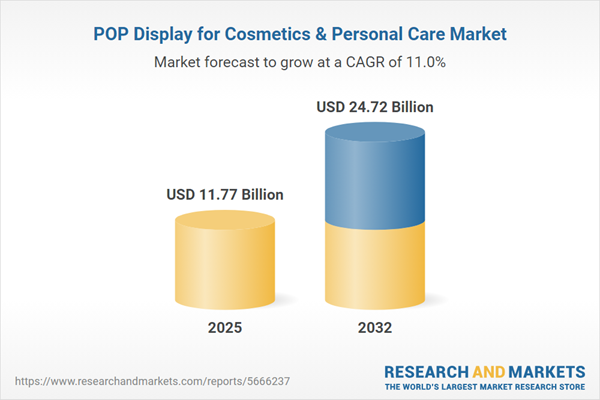Speak directly to the analyst to clarify any post sales queries you may have.
The POP Display for Cosmetics & Personal Care Market is evolving rapidly, with point-of-purchase displays becoming essential platforms for consumer engagement and brand storytelling. Senior decision-makers are focusing on innovative and sustainable solutions to drive in-store experiences and competitive differentiation.
Market Snapshot of POP Display for Cosmetics & Personal Care
The global Point-of-Purchase (POP) Display market dedicated to cosmetics and personal care products is experiencing robust expansion. Valued at USD 10.71 billion in 2024, it is projected to reach USD 11.77 billion in 2025 and expand further at a CAGR of 11.02%, hitting USD 24.72 billion by 2032.
This growth is fueled by increasing demand for impactful merchandising tools that merge functionality with visual and digital sophistication across diverse retail environments.Scope & Segmentation: Depth Across Formats, Materials, Technologies, and Channels
- Product Types: Countertop displays, shelf displays, wall displays, dump bins, floor displays, kiosks, and totem displays.
- Material Types: Acrylic, cardboard, metal, plastic, wood.
- Technologies: Digital displays, static displays.
- End-User Channels: Convenience stores, departmental stores, experience stores, specialty stores, supermarkets.
- Regions Covered: Americas (North America, Latin America), Europe, Middle East & Africa (Europe, Middle East, Africa), Asia-Pacific.
- Company Coverage: Profiles leading global and regional players specializing in design, materials, and full-service manufacturing for POP displays, including both established industry leaders and innovative niche firms.
Key Takeaways for Senior Decision-Makers
- Point-of-purchase displays exert influence at critical decision points, blending tactile appeal with brand narratives to shape consumer purchasing behavior.
- Integration of digital and interactive features—such as AR try-ons and smart shelving—supports immersive experiences and valuable data collection for future product lines.
- Sustainability initiatives are prompting brands to adopt recyclable materials and reconfigurable designs, aligning display strategies closely with eco-conscious consumer preferences.
- Manufacturers are strengthening regional supply chains, investing in local partnerships, and refining value engineering to navigate supply disruption and cost management complexities.
- Segmented approaches by product type, channel, and region enable brands to create differentiated in-store campaigns that resonate with specific shopper profiles.
Tariff Impact: U.S. Policy Changes Reshaping Supply Dynamics
Revised United States tariffs in 2025 have impacted the POP Display for Cosmetics & Personal Care Market, especially for imported materials such as acrylic and metal. As responses, manufacturers are recalibrating sourcing approaches, forming long-term alliances with domestic suppliers, and optimizing design to reduce material dependency and cost volatility. These changes have spurred a renewed focus on supply chain resilience and design innovation, influencing competitive strategy for both brands and retailers.
Methodology & Data Sources
This research leverages a multi-phase approach—combining primary interviews with display manufacturers, materials experts, and retail leaders, alongside secondary reviews of industry journals, trade publications, and technical documentation. Data triangulation and on-site validation enhance the accuracy of qualitative and quantitative findings, ensuring a thorough understanding of technology trends, consumer behavior, and regulatory influences.
Why This Report Matters for B2B Decision-Makers
- Guides strategic investments with in-depth segmentation for emerging technologies, materials, and regional opportunities in the POP display market.
- Assists in risk mitigation by outlining the implications of supply chain shifts and tariff adjustments across global and local contexts.
- Provides actionable insight for sustainable and digital merchandising transformation, aligning with evolving consumer and retailer expectations.
Conclusion
The POP Display for Cosmetics & Personal Care Market continues to present new opportunities for value creation through innovation, sustainable practices, and tailored channel strategies. This report equips leaders with a robust foundation for forward-looking decisions amid a dynamic retail landscape.
Additional Product Information:
- Purchase of this report includes 1 year online access with quarterly updates.
- This report can be updated on request. Please contact our Customer Experience team using the Ask a Question widget on our website.
Table of Contents
3. Executive Summary
4. Market Overview
7. Cumulative Impact of Artificial Intelligence 2025
Companies Mentioned
The companies profiled in this POP Display for Cosmetics & Personal Care market report include:- Abbe Pty Ltd.
- Adequate Steel Fabricators
- Ardent Displays
- Array Marketing
- Ashtonne Packaging
- Avante Point-Of-Purchase Displays
- Bling Bling Creative Custom Packaging
- DIAM Group
- Diamond Cosmetics
- DS Smith PLC
- Felbro, Inc.
- Great Little Box Company Ltd.
- Great Northern Corporation
- Hicon POP Displays Ltd.
- JC Display Packaging Co., Ltd
- KSF Global Ltd.
- Kunshan Deco POP Display Co., Ltd.
- Landaal Packaging Systems
- Marketing Alliance Group
- Menasha Packaging Company, LLC
- Mitchel-Lincoln Packaging Ltd.
- PAX Solutions, Inc.
- PILOTES
- POP Solutions S.A.
- PPDANDG.com, Inc.
- Printex Transparent Packaging
- Rich Ltd. by DGS Retail
- RTC Europe Ltd.
- Shenzhen LangYi Packaging Display Co., Ltd.
- Smurfit Kappa Group PLC
- Sonoco Products Company
- Stephen Gould Corporation
- The Vomela Companies
- TPH Global Solutions
- Wrights Plastics
Table Information
| Report Attribute | Details |
|---|---|
| No. of Pages | 190 |
| Published | November 2025 |
| Forecast Period | 2025 - 2032 |
| Estimated Market Value ( USD | $ 11.77 Billion |
| Forecasted Market Value ( USD | $ 24.72 Billion |
| Compound Annual Growth Rate | 11.0% |
| Regions Covered | Global |
| No. of Companies Mentioned | 36 |









